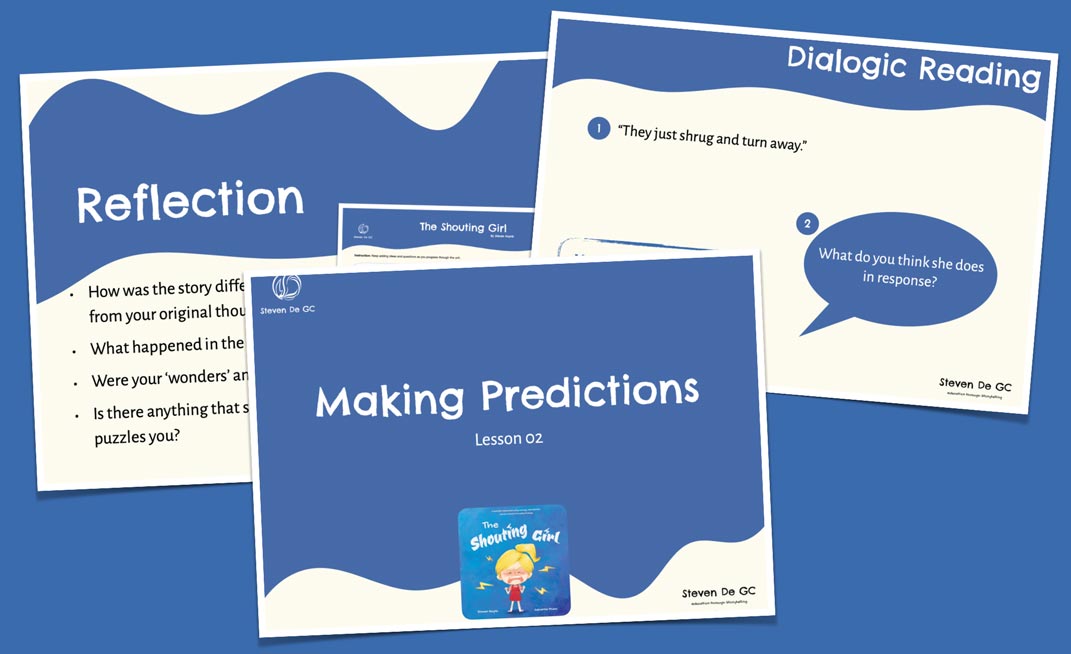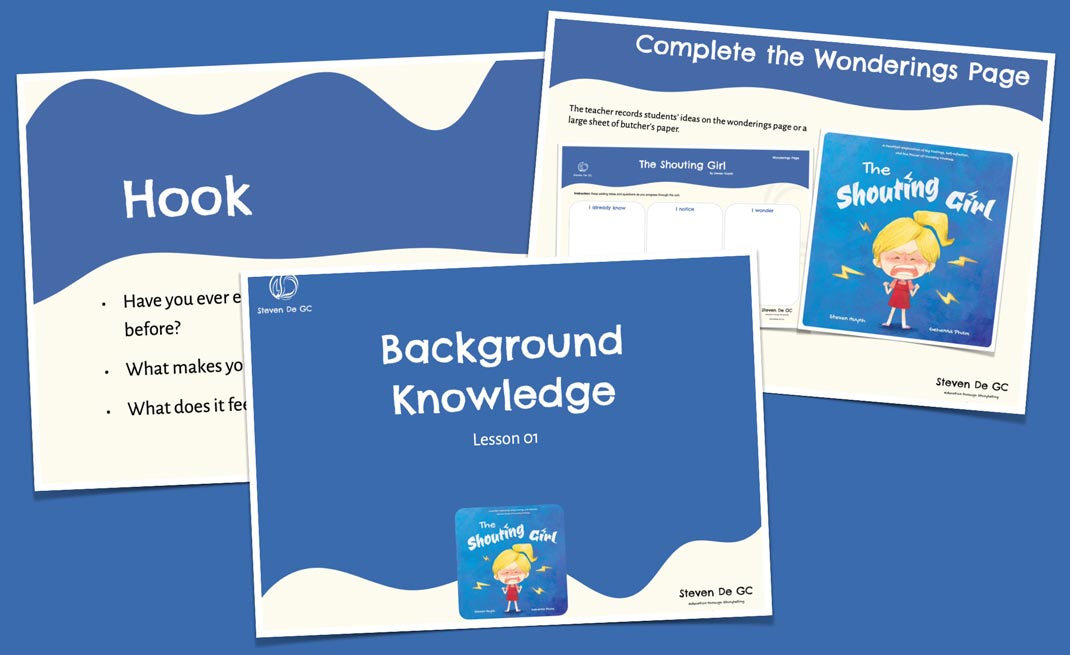AC9E2LY05
English Language and Literacy | Year 2
Use comprehension strategies such as visualising, predicting, connecting, summarising, monitoring and questioning to build literal and inferred meaning
Elaborations
• listening for specific information and providing key facts or points from an informative or persuasive text
• listening and responding to detailed instructions
• integrating information from print, images and prior knowledge to make supportable inferences
• identifying the main idea of a text
• predicting vocabulary that is likely to be in a text, based on the topic and the purpose of the text; for example, predicting that “station” and “arrive” would be in a text recounting a train journey
• using prior knowledge to make and confirm predictions when reading a text
• using graphic organisers to represent the connections between characters, order of events or sequence of information
Expand | Collapse Search filter
-
The Shouting Girl: L2 Making Predictions
📔 The Shouting Girl by Steven Huynh• We are learning to make predictions about the text.
-
The Shouting Girl – L1 Background Knowledge
📔 The Shouting Girl by Steven Huynh• We are learning to build our background knowledge to help us comprehend a text.
-
[T4R] Let’s Build a Boat Reading/Design Unit for Year 1/2
📔 Let’s Build A Boat by Jane GodwinAC9E1LA02 (English Language and Literacy)AC9E1LA08 (English Language and Literacy)AC9E1LA09 (English Language and Literacy)AC9E1LE03 (English Language and Literacy)AC9E1LE05 (English Language and Literacy)AC9E1LY02 (English Language and Literacy)AC9E1LY05 (English Language and Literacy)AC9E1LY06 (English Language and Literacy)AC9E2LA02 (English Language and Literacy)AC9E2LA08 (English Language and Literacy)AC9E2LE03 (English Language and Literacy)AC9E2LE05 (English Language and Literacy)AC9E2LY02 (English Language and Literacy)AC9E2LY05 (English Language and Literacy)AC9TDE2K01 (Design and Technologies)AC9TDE2K02 (Design and Technologies)AC9TDE2P01 (Design and Technologies)AC9TDE2P02 (Design and Technologies)AC9TDE2P03 (Design and Technologies)AC9TDE2P04 (Design and Technologies) -
[T4R] Let’s Build a Boat: L11 Evaluation and Reflection
📔 Let’s Build A Boat by Jane Godwin• We are learning to evaluate and reflect on the text and your boat.
-
[T4R] Let’s Build a Boat: L10 Summarising
📔 Let’s Build A Boat by Jane Godwin• We are learning to summarise the story.
-
[T4R] Let’s Build a Boat: L9 Making Inferences
📔 Let’s Build A Boat by Jane Godwin• We are learning to make inferences about the text and understand the message of the story.
-
[T4R] Let’s Build a Boat: L4 Literal Retrieval
📔 Let’s Build A Boat by Jane Godwin• We are learning to find information from the text to help us understand it better.
-
[T4R] Let’s Build a Boat: L3 Making Connections
📔 Let’s Build A Boat by Jane Godwin• We are learning to respond to a text.
AC9E1LA02 (English Language and Literacy – Year 1) AC9E1LA08 (English Language and Literacy – Year 1) AC9E1LE02 (English Language and Literacy – Year 1) AC9E1LY05 (English Language and Literacy – Year 1) AC9E2LA02 (English Language and Literacy – Year 2) AC9E2LA08 (English Language and Literacy – Year 2) AC9E2LE02 (English Language and Literacy – Year 2) AC9E2LY05 (English Language and Literacy – Year 2) AC9TDE2P01 (Design and Technologies – Year 1,Year 2) -
[T4R] Let’s Build a Boat: L2 Making Predictions
📔 Let’s Build A Boat by Jane Godwin• We are learning to make predictions about the text.
AC9E1LA08 (English Language and Literacy – Year 1) AC9E1LY02 (English Language and Literacy – Year 1) AC9E1LY05 (English Language and Literacy – Year 1) AC9E2LA08 (English Language and Literacy – Year 2) AC9E2LY02 (English Language and Literacy – Year 2) AC9E2LY05 (English Language and Literacy – Year 2) AC9TDE2K01 (Design and Technologies – Year 1,Year 2) -
[T4R] Let’s Build a Boat: L1 Background Knowledge
📔 Let’s Build A Boat by Jane Godwin• We are learning to use what we already know to help us understand the text.
-
[T4R] Stay For Dinner Reading Unit for Year 2
📔 Stay For Dinner by Sandhya ParappukkaranAC9E2LA02 (English Language and Literacy)AC9E2LA03 (English Language and Literacy)AC9E2LA08 (English Language and Literacy)AC9E2LA09 (English Language and Literacy)AC9E2LE02 (English Language and Literacy)AC9E2LE03 (English Language and Literacy)AC9E2LY02 (English Language and Literacy)AC9E2LY04 (English Language and Literacy)AC9E2LY05 (English Language and Literacy)AC9E2LY06 (English Language and Literacy)AC9E2LY07 (English Language and Literacy)AC9HP2P01 (Health and Physical Education)AC9HP2P02 (Health and Physical Education)AC9HP2P03 (Health and Physical Education) -
[T4R] Stay For Dinner: L6 The Message
📔 Stay For Dinner by Sandhya Parappukkaran• We are learning to use dialogic talk to deepen our understanding of the text.
-
[T4R] Stay For Dinner: L5 Vocabulary
📔 Stay For Dinner by Sandhya Parappukkaran• We are learning the meaning of unknown words in context.
-
[T4R] Stay For Dinner: L4 Literal Retrieval
📔 Stay For Dinner by Sandhya Parappukkaran• We are learning to retrieve literal information from the text.
-
-
[T4R] Stay For Dinner: L2 Making Predictions
📔 Stay For Dinner by Sandhya Parappukkaran• We are learning to make predictions about the text.





![[T4R] Let’s Build a Boat Reading/Design Unit for Year 1/2](https://stevendegc.com.au/wp-content/uploads/2025/05/LetsBuildaBoat-T4R-Overview-Cover.jpg)
![[T4R] Let’s Build a Boat: L11 Evaluation and Reflection](https://stevendegc.com.au/wp-content/uploads/2025/05/LetsBuildaBoat-T4R-Lesson11-Cover.jpg)
![[T4R] Let’s Build a Boat: L10 Summarising](https://stevendegc.com.au/wp-content/uploads/2025/05/LetsBuildaBoat-T4R-Lesson10-Cover.jpg)
![[T4R] Let’s Build a Boat: L9 Making Inferences](https://stevendegc.com.au/wp-content/uploads/2025/05/LetsBuildaBoat-T4R-Lesson9-Cover.jpg)
![[T4R] Let’s Build a Boat: L4 Literal Retrieval](https://stevendegc.com.au/wp-content/uploads/2025/05/LetsBuildaBoat-T4R-Lesson4-Cover.jpg)
![[T4R] Let’s Build a Boat: L3 Making Connections](https://stevendegc.com.au/wp-content/uploads/2025/05/LetsBuildaBoat-T4R-Lesson3-Cover.jpg)
![[T4R] Let’s Build a Boat: L2 Making Predictions](https://stevendegc.com.au/wp-content/uploads/2025/05/LetsBuildaBoat-T4R-L2-Cover.jpg)
![[T4R] Let’s Build a Boat: L1 Background Knowledge](https://stevendegc.com.au/wp-content/uploads/2025/05/LetsBuildaBoat-T4R-L1-Cover.jpg)
![[T4R] Stay For Dinner Reading Unit for Year 2](https://stevendegc.com.au/wp-content/uploads/2025/02/T4R-Stay-For-Dinner-UnitOverviewCover.jpg)
![[T4R] Stay For Dinner: L6 The Message](https://stevendegc.com.au/wp-content/uploads/2025/02/T4R-Stay-For-Dinner-L6-Cover.jpg)
![[T4R] Stay For Dinner: L5 Vocabulary](https://stevendegc.com.au/wp-content/uploads/2025/02/T4R-Stay-For-Dinner-L5-Cover.jpg)
![[T4R] Stay For Dinner: L4 Literal Retrieval](https://stevendegc.com.au/wp-content/uploads/2025/02/T4R-Stay-For-Dinner-L4-Cover.jpg)
![[T4R] Stay For Dinner: L3 Book Talk](https://stevendegc.com.au/wp-content/uploads/2025/01/T4R-Stay-For-Dinner-L3-Cover.jpg)
![[T4R] Stay For Dinner: L2 Making Predictions](https://stevendegc.com.au/wp-content/uploads/2025/01/T4R-Stay-For-Dinner-L2-Cover-1.jpg)